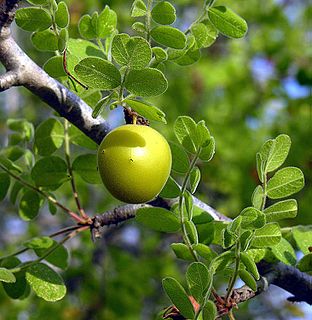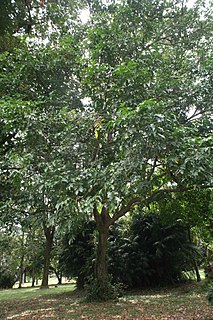
Astronium is a genus of flowering plants in the cashew family, Anacardiaceae. It is native to Central and South America.

Campnosperma is a genus of plant in the family Anacardiaceae.

Nothopegia is a genus of plants in the family Anacardiaceae.

Poupartia is a genus of plant in family Anacardiaceae. From the islands of Madagascar, Mauritius, Rodrigues and Réunion, all in the Indian Ocean.

Uvaria is a genus of flowering plants in the family Annonaceae. The generic name uvaria is derived from the Latin uva meaning grape, likely because the edible fruit of some species in the genus resemble grapes.

Drimycarpus is a small genus of trees in the cashew and sumac family Anacardiaceae. The generic name is from the Greek meaning "pungent fruit".

Amphipterygium is a small genus in the subfamily Anacardioideae of the cashew and sumac family Anacardiaceae.
Dobinea is a small genus of plants in the subfamily Anacardioideae of the cashew and sumac family Anacardiaceae. The species are dioecious and grow as shrubs or perennial herbs. They grow naturally in the East Himalaya region and China.
Fegimanra is a small genus of trees in the subfamily Anacardioideae of the cashew and sumac family Anacardiaceae. They grow naturally in west and west-central tropical Africa.
Pseudosmodingium is a genus of plants in the subfamily Anacardioideae of the cashew and sumac family Anacardiaceae.
Bonetiella is a monotypic genus of shrubs in the subfamily Anacardioideae of the cashew and sumac family Anacardiaceae. It contains the single species Bonetiella anomala, which is endemic to northern and central Mexico.
Campylopetalum is a monotypic genus of shrubs in the subfamily Anacardioideae of the cashew and sumac family Anacardiaceae. It contains the single species Campylopetalum siamense, which is endemic to northern Thailand.
Cardenasiodendron is a monotypic genus of dioecious trees in the subfamily Anacardioideae of the cashew and sumac family Anacardiaceae. It contains the single species Cardenasiodendron brachypterum, which is endemic to Bolivia.
Faguetia is a monotypic genus of trees in the subfamily Anacardioideae of the cashew and sumac family Anacardiaceae. It contains the single species Faguetia falcata, which is endemic to eastern Madagascar.
Laurophyllus is a monotypic genus of dioecious shrubs in the subfamily Anacardioideae of the cashew and sumac family Anacardiaceae. It contains the single species Laurophyllus capensis, which is endemic to the Eastern Cape province of South Africa. The species is found on wooded hillsides and by streams.
Mosquitoxylum is a monotypic genus of trees in the subfamily Anacardioideae of the cashew and sumac family Anacardiaceae. It contains the single species Mosquitoxylum jamaicense, which grows naturally from southern Mexico to Ecuador and also in Jamaica.
Orthopterygium is a monotypic genus of dioecious plants in the subfamily Anacardioideae of the cashew and sumac family Anacardiaceae. It contains the single species Orthopterygium huaucui, which is endemic to western Peru.

Cyrtocarpa is a genus of trees in the subfamily Spondiadoideae of the cashew and sumac family Anacardiaceae. Their habitat is dry forests to open arid areas. They grow naturally in Mexico and northern South America.
Pegia is a genus of plants in the subfamily Spondiadoideae of the cashew and sumac family Anacardiaceae.

Pseudospondias is a genus of plants in the subfamily Spondiadoideae of the cashew and sumac family Anacardiaceae. They grow as dioecious shrubs or trees and are found in forests of Sub-Saharan Africa.









